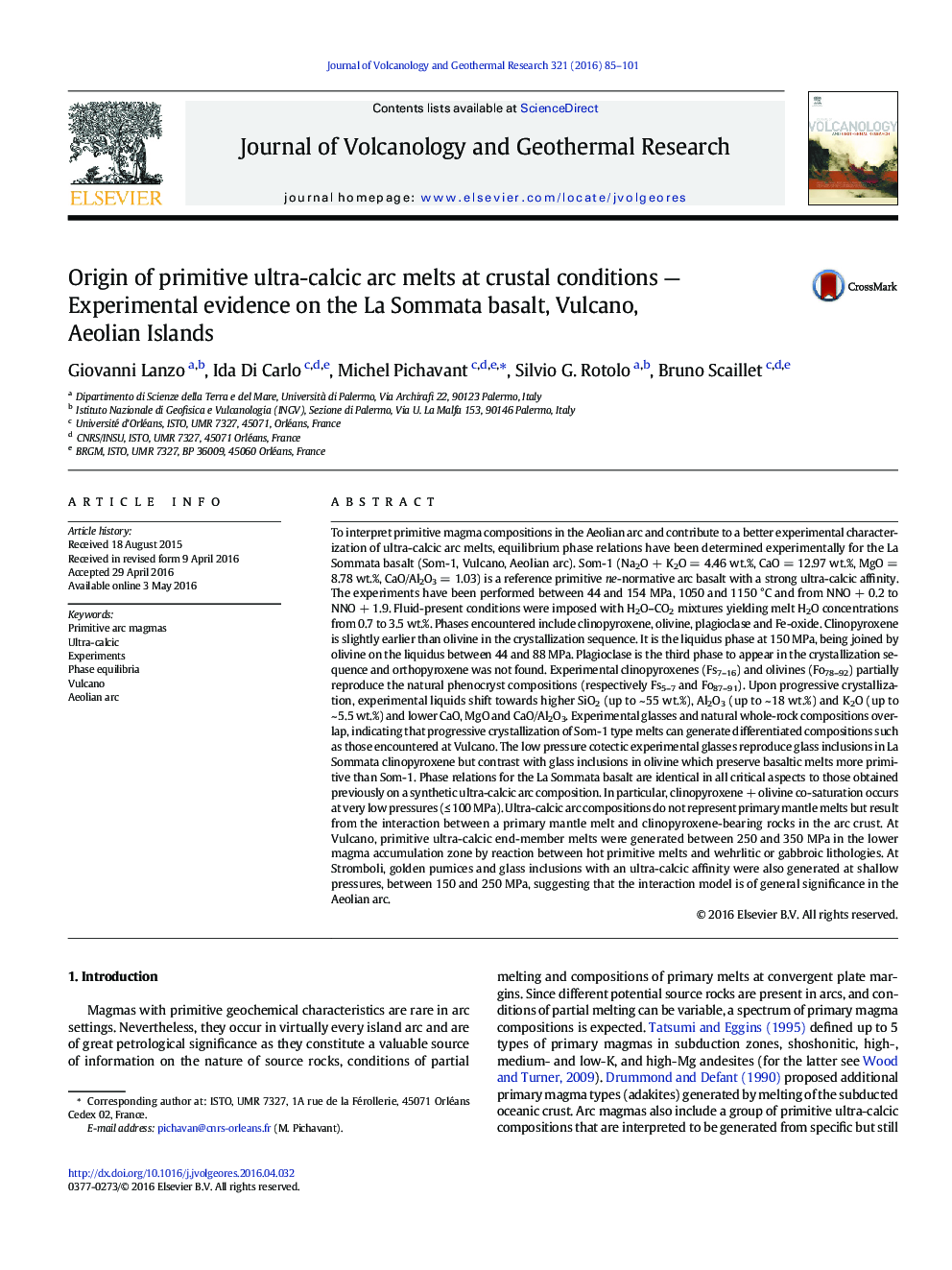| کد مقاله | کد نشریه | سال انتشار | مقاله انگلیسی | نسخه تمام متن |
|---|---|---|---|---|
| 4712965 | 1638301 | 2016 | 17 صفحه PDF | دانلود رایگان |

• The experimental phase relations of a natural ultra-calcic arc basalt have been determined
• Results are identical in critical aspects to those obtained previously on a synthetic ultra-calcic arc composition
• Generation of primitive ultra-calcic melt leaves a clinopyroxene-rich residual source, either wehrlite or clinopyroxenite
• Ultra-calcic arc compositions at Vulcano are generated at crustal pressures
• They represent melts produced by the interaction between primary and clinopyroxene-rich wall-rocks
To interpret primitive magma compositions in the Aeolian arc and contribute to a better experimental characterization of ultra-calcic arc melts, equilibrium phase relations have been determined experimentally for the La Sommata basalt (Som-1, Vulcano, Aeolian arc). Som-1 (Na2O + K2O = 4.46 wt.%, CaO = 12.97 wt.%, MgO = 8.78 wt.%, CaO/Al2O3 = 1.03) is a reference primitive ne-normative arc basalt with a strong ultra-calcic affinity. The experiments have been performed between 44 and 154 MPa, 1050 and 1150 °C and from NNO + 0.2 to NNO + 1.9. Fluid-present conditions were imposed with H2O–CO2 mixtures yielding melt H2O concentrations from 0.7 to 3.5 wt.%. Phases encountered include clinopyroxene, olivine, plagioclase and Fe-oxide. Clinopyroxene is slightly earlier than olivine in the crystallization sequence. It is the liquidus phase at 150 MPa, being joined by olivine on the liquidus between 44 and 88 MPa. Plagioclase is the third phase to appear in the crystallization sequence and orthopyroxene was not found. Experimental clinopyroxenes (Fs7–16) and olivines (Fo78–92) partially reproduce the natural phenocryst compositions (respectively Fs5–7 and Fo87–91). Upon progressive crystallization, experimental liquids shift towards higher SiO2 (up to ~ 55 wt.%), Al2O3 (up to ~ 18 wt.%) and K2O (up to ~ 5.5 wt.%) and lower CaO, MgO and CaO/Al2O3. Experimental glasses and natural whole-rock compositions overlap, indicating that progressive crystallization of Som-1 type melts can generate differentiated compositions such as those encountered at Vulcano. The low pressure cotectic experimental glasses reproduce glass inclusions in La Sommata clinopyroxene but contrast with glass inclusions in olivine which preserve basaltic melts more primitive than Som-1. Phase relations for the La Sommata basalt are identical in all critical aspects to those obtained previously on a synthetic ultra-calcic arc composition. In particular, clinopyroxene + olivine co-saturation occurs at very low pressures (≤ 100 MPa). Ultra-calcic arc compositions do not represent primary mantle melts but result from the interaction between a primary mantle melt and clinopyroxene-bearing rocks in the arc crust. At Vulcano, primitive ultra-calcic end-member melts were generated between 250 and 350 MPa in the lower magma accumulation zone by reaction between hot primitive melts and wehrlitic or gabbroic lithologies. At Stromboli, golden pumices and glass inclusions with an ultra-calcic affinity were also generated at shallow pressures, between 150 and 250 MPa, suggesting that the interaction model is of general significance in the Aeolian arc.
Journal: Journal of Volcanology and Geothermal Research - Volume 321, 15 July 2016, Pages 85–101